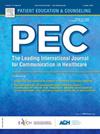Applications in human-centered design: Shared-Decision Making for mental health treatment in primary care
IF 2.9
2区 医学
Q2 PUBLIC, ENVIRONMENTAL & OCCUPATIONAL HEALTH
引用次数: 0
Abstract
Objective
Shared Decision Making (SDM) is heralded as a standard for patient-centered care, but implementation of SDM in routine mental health practice has proven difficult to achieve. Human-centered design (HCD) may hold promise for improving SDM implementation in busy clinical settings. This study describes applying HCD to develop an SDM documentation support tool intended to encourage successful use of SDM by mental health clinicians.
Methods
This descriptive, proof-of-concept study utilized the Discover-Design-Build-Test HCD framework to simplify a comprehensive SDM protocol for mental health decision making. Implementation was piloted within multiple primary care clinics. The study consisted of three phases: information gathering (interviewing clinicians), solution generation and prototyping, and testing a final prototype in routine care settings.
Results
Our project proceeded through eight cycles of user design and feedback. Clinicians pilot tested the final product, a documentation note template incorporating SDM prompts and explanations. It is currently available for clinical use.
Conclusions
Clinicians were able to use the HCD-redesigned SDM documentation note template intuitively, i.e., without explicit instruction. Leveraging buy-in from users throughout the entirety of the process (from problem investigation to solution discussions) created opportunities to tailor implementation strategies and may support ownership of the end-product by primary stakeholders.
Practice implications
HCD may be a promising methodology for streamlining the adoption of complex clinical tasks like SDM.
以人为本设计的应用:初级保健中心理健康治疗的共同决策
目的共享决策(shared Decision Making, SDM)被倡导为以患者为中心的护理标准,但SDM在日常精神卫生实践中的实施被证明是难以实现的。以人为本的设计(HCD)有望在繁忙的临床环境中改善SDM的实施。本研究描述了应用HCD来开发SDM文档支持工具,旨在鼓励心理健康临床医生成功使用SDM。方法本研究采用发现-设计-构建-测试HCD框架,简化心理健康决策的综合SDM方案。在多个初级保健诊所进行了试点。该研究包括三个阶段:信息收集(采访临床医生)、解决方案生成和原型设计,以及在常规护理环境中测试最终原型。我们的项目进行了八个周期的用户设计和反馈。临床医生对最终产品进行了试点测试,这是一个包含SDM提示和解释的文档说明模板。目前可用于临床。结论临床医生能够直观地使用hcd重新设计的SDM文档笔记模板,即无需明确指导。在整个过程中(从问题调查到解决方案讨论)利用用户的支持,创造了裁剪实现策略的机会,并可能支持主要涉众对最终产品的所有权。实践意义shcd可能是一种很有前途的方法,可以简化采用复杂的临床任务,如SDM。
本文章由计算机程序翻译,如有差异,请以英文原文为准。
求助全文
约1分钟内获得全文
求助全文
来源期刊

Patient Education and Counseling
医学-公共卫生、环境卫生与职业卫生
CiteScore
5.60
自引率
11.40%
发文量
384
审稿时长
46 days
期刊介绍:
Patient Education and Counseling is an interdisciplinary, international journal for patient education and health promotion researchers, managers and clinicians. The journal seeks to explore and elucidate the educational, counseling and communication models in health care. Its aim is to provide a forum for fundamental as well as applied research, and to promote the study of organizational issues involved with the delivery of patient education, counseling, health promotion services and training models in improving communication between providers and patients.
 求助内容:
求助内容: 应助结果提醒方式:
应助结果提醒方式:


